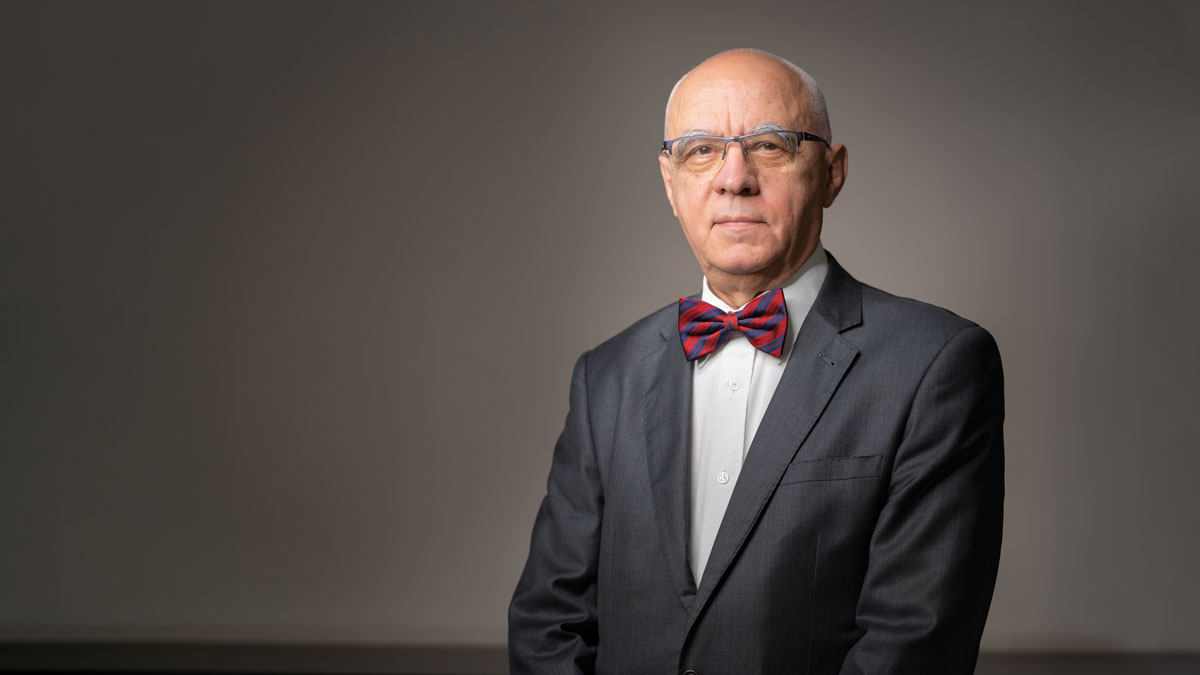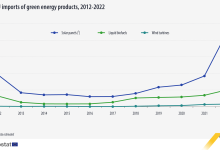Talking to Experts: Teodor Chirica, PhD, Honorary President of the Romanian Atomic Forum
Graduate of the Polytechnic University of Bucharest, with a solid experience in Romania’s nuclear industry, Teodor Chirica, PhD, has significantly contributed to the establishment of the Romanian Atomic Forum (ROMATOM), as co-founder, and to its affiliation to the European Atomic Forum (FORATOM), whose President he was during 2018-2019.
In an extensive interview, Mr. Teodor Chirica, PhD, discusses about Romania’s entry in the elite club of European professionals in the nuclear field, the implications of completing Units 3 and 4 in Cernavoda, the production of hydrogen in Romania, and the role of nuclear power in the energy mix of the future.
Certification of Romanian experts’ competencies in the nuclear industry has contributed to Romania’s positioning on the European map of this field, also based on strategic nuclear projects carried out by our country. How was ROMATOM founded and how did Romania join the elite club of European nuclear power experts?
Teodor Chirica: After December 1989, several professional associations started to emerge in Romania, as a result of a natural trend of the various professions and fields of activity to promote and defend their interests, aligned with similar international or European associations. In the engineering field, in 1990, the General Association of Engineers in Romania (AGIR) takes back its old name from 1918. Also, the Romanian National Committee of World Energy Council (RNC-WEC), a founding member of the World Energy Council created in 1923, and the Romanian National Institute for Energy Development Studies (IRE), re-established in 1990 and affiliated with EURELECTRIC, are two respectable associations operating in the field of electricity.
It was normal for the nuclear sector in Romania to develop its own associations, the first being the Romanian “Nuclear Energy” Association (AREN), founded in 1990 as a learned association of professionals, individuals in the field of nuclear power.
Also, on May 7, 1996, the Nuclear Union of Romanian Industry (UNIR), was founded in Cernavoda, an association consisting of individuals, which made its voice heard, publishing statements and calls to decision-makers, documenting the proposed objectives, through numbers that proved the benefits of continuing the Romanian Nuclear Program. UNIR dissolved itself after the establishment of the Romanian Atomic Forum.
In 2000, the nuclear industry in Romania had the first contacts with the European Atomic Forum (FORATOM), an association of the European nuclear industry, bringing together the national fora of the nuclear industries in the Member States of the European Union or those in the process of accession to the European Union. FORATOM acts as the voice of the European nuclear industry in energy policy discussions with EU Institutions and other key stakeholders.
At the time, the need for an association promoting industry’s interests, having the necessary strength and representativeness, consisting of individuals activating in the field of nuclear power was very clearly understood. Also, the importance for this association to operate in Bucharest, the capital of Romania, where it could have an easier access to state institutions, to media, as well as to the other energy associations, was realized.
Then, an initiative group was set-up, consisting of representatives of Nuclearelectrica (Teodor Chirica, director), Nuclearmontaj (Mihai Cornescu, director), UNIR (Horea Mocanu, secretary general) and GeneralTurbo (Dinu Vasiliu, director), legal advice being provided by Mr. Vlad Chiripus. The initiative group analysed the options, foreshadowing the new association, proposing the name of Romanian Atomic Forum (ROMATOM), defined its objectives, and prepared the first drafts of the Articles of Incorporation and Statute.
The Initiative Committee, eager to become part of the European nuclear industry as soon as possible, addressed to the FORATOM General Assembly the approval of ROMATOM accession. FORATOM answer was favourable, ROMATOM becoming a member of the European Atomic Forum on December 13, 2000. We are proud that the Romanian nuclear industry has opened the door to the European Union, as the vanguard of Romania’s accession to the European family!
On January 10, 2001, Constituent General Assembly, including 16 founding members, – Nuclearelectrica, 13 companies and two associations (AREN and UNIR) founded the Romanian Atomic Forum (ROMATOM), a Romanian legal entity governed by private law, an independent union representative at national level, non-profit and non-lucrative, non-governmental, apolitical, consisting of Romanian and/or foreign legal entity members. The Constituent General Assembly approved the Articles of Incorporation and the Statute of the Association, elected the President and the Board of Directors, approving the activity program and the budget for the current year.
By resolution of the Bucharest District Court 1, following the session of May 3, 2001, ROMATOM acquired legal personality, obtaining the Certificate of registration with the register of associations and foundations at the Registry of the Bucharest District Court 1 on June 19, 2001.
Since then, ROMATOM has carried out a continuous activity, having the direct support of its members, both nationally and internationally. Within FORATOM we are represented in most Working Groups and task Forces, taking part in drafting the policy documents of the European nuclear industry, including positions addressed to European Institutions, together with EU’s nuclear companies. ROMATOM has an active participation in public consultations and public debates initiated by European institutions, as well as those of national interest.
Currently, ROMATOM has 40 members, legal entities in the fields of power production, research, innovation and development, engineering and consulting, manufacturing of nuclear equipment and components, construction-erection, radioactive waste management and new applications of nuclear power.
Today, ROMATOM presidency is held by Water Tosto Bucharest, Chairing the Board of Directors, too. The other members of the Board of Directors are Automatica, Ansaldo Nucleare Romania, ICSI Ramnicu Valcea, Kinectrics Romania, Matefin and Nuclearelectrica, and as alternate members – Elcomex and Titan Echipamente Nucleare.
However, according to data published by Eurostat for 2019, Romania is among the 13 EU Member States that produce electricity in nuclear power plants, but production has fallen below that of the other countries in the region. What is the explanation?
Teodor Chirica: Indeed, Romania is part of the ‘European nuclear club’ starting with December 2, 1996, when Unit no. 1 from Cernavoda NPP started commercial operation, with an installed capacity of 706,5 MWe, doubled in September 2007, when Unit 2 started the commercial operation of the second unit. Unit 2 from Cernavoda is still the last nuclear unit commissioned in the EU. Before Cernavoda Unit 2, other two units of 1000 MW each in Temelin, Czech Republic (2002, respectively 2003), and two in Mochovce of 440 MW each, in Slovakia (1988, respectively 2000) have been commissioned. In this entire period, production of electricity delivered into the Romanian energy system remained relatively constant, around the figure of 10,000,000 – 10,500,000 MWh.
We can therefore say that the power production from nuclear sources has neither decreased nor increased in Romania compared to other states in the Central and Eastern Europe. The situation of nuclear capacities installed and operational in the last 15 years, in the region, is the following:
1.Czech Republic, 6 nuclear reactors – 3,932 MW net, 35% of the country’s electricity production
2.Bulgaria, 2 nuclear reactors – 1,966 MW net, 35%
3.Hungary, 4 nuclear reactors – 1,902 MW net, 49%
4.Slovakia, 4 nuclear reactors – 1,814 MW net, 55%
5.Romania, 4 nuclear reactors – 1,300 MW net, 18%
6.Slovenia, 1 nuclear reactor – 688 MW net, 37%
It should be noted that in the region Slovakia has two new units at Mochovce, delayed projects, Unit 3 just obtained the operating license in May 2021, and Unit 4 is closer to be operational, and Hungary is more advanced on the construction of new nuclear reactors, having a contract with ROSATOM for two VVER nuclear units of 1,200 MW each and received the construction permit from the Hungarian nuclear safety authority in the second half of 2020. Czechia, Bulgaria, Poland, and Romania have plans to build new nuclear capacities, included in the energy strategies of these states.
An example worth mentioning is France, which obtains over 70% of its electricity from nuclear power plants, and which has selected nuclear projects within the National Recovery and Resilience Plan. Do you know similar examples in Europe? What is the situation in Romania?
Teodor Chirica: It is difficult to make a comparison between France and Romania, the priorities being different and hence the distribution of funds requested by the two states through the National Recovery and Resilience Plan (PNRR) is different. For example, we cannot compare the situation of railways or road infrastructure in France with Romania’s situation, and our decision-makers fought a diplomatic battle for financing highways. Also, there are tight deadlines imposed by European institutions, as projects subject to NRRP should be implemented by 2026, deadline which is incompatible with Romania’s nuclear projects. In France, relatively small projects were selected within the NRRP, focused on investments in new activities and upgrades, such as the development and qualification of a new production capacity for manufacturing accident tolerant fuel, these projects being able to meet the aforementioned deadlines.
I don’t know other EU Member States that have selected nuclear projects for funding within NRRP.
In Romania, nuclear energy covers 18% of domestic production and 35% of total clean energy produced in the country, according to Nuclearelectrica annual report for 2020, creating 11,000 jobs in production, research, engineering, works, production of equipment, innovation, education. What would the completion of Units 3 and 4 in Cernavoda mean from this point of view?
Teodor Chirica: I can add that in Romania from the commissioning of Units 1 and 2, the release of around 170 million tons of greenhouse gases (GHG) was avoided. The volume of high-risk waste is very low compared to other sources of baseload energy production, these being stored at the Cernavoda plant, in intermediate facilities and at the right time being transferred to final radioactive waste repositories.
As economic and social impact, today, nuclear industry’s contribution to Romania’s GDP is about EUR 590 million. Also, the completion of Units 3 and 4 in Cernavoda NPP will increase the number of jobs in the nuclear industry to around 19.000 people, mostly highly qualified staff, with a corresponding increase in the Gross Domestic Product of our country. The amount of the investments estimated until 2030 in Romania’s new nuclear projects is of about RON 8-9 billion.
The new nuclear units in Cernavoda NPP, Unit 3 following to be completed by 2030 and, respectively, Unit 4 by 2031, will contribute to consolidating Romania’s security of supply, reaching the assumed environmental targets, as well as an increase in welfare of the population.
The up-dated Feasibility Study for Cernavoda Units 3 and 4, shows that the Project is financially sustainable, the cash flow requirements being met, and by refurbishment of Unit 1, we add another 30 years of operation and clean production, at a half cost than a new unit – here the economic efficiency is not too difficult to be demonstrated. Analyses made by the European Commission and other international institutions show that the life extension of nuclear units will have a significant impact on the reduction of GHG emissions, with economic benefits, in the transition period, until the resumption at large-scale of new nuclear projects. Also, studies in the USA and Europe have shown that every dollar or euro spent on the nuclear industry results in four times that investment in the broader economy.
Development of new nuclear capacities, with low carbon emissions, will contribute to the stability of the energy system, ensuring the diversification of electricity supply sources, together with the new technologies using renewable sources (RES), by taking over the decommissioning of conventional, coal-fired power plants, at the end of their lifetime.
According to Integrated National Energy and Climate Plan (PNIESC), Romania aims to reduce GES emissions by 2030 by 43,9%, compared with 2005 and to reduce its dependency on energy imports from 20,8% today to 17,8% by 2030 which is one of the lowest levels in the EU. These targets cannot be achieved without the contribution of additional nuclear power capacities. Cernavoda NPP Units 3 and 4 are envisaged in the PNIESC as pillars of energy independence and decarbonization.
It’s important that in Romania there is an active “supply chain”, with the experience of Units 1 and 2 from Cernavoda, ready to embark on a new nuclear project, a large part being among ROMATOM members. Even if in recent years the pace of development of the nuclear program has been reduced, many of our members are involved in nuclear projects, such as the construction of new nuclear power plants outside Romania or in ITER Tokamak experiment, being interested in advanced technologies, for example the ALFRED Project, as well as providing support for operating and maintenance services for existing Cernavoda units.
According to the analyses made by ROMATOM in 2013 and updated in 2018, investigating both ROMATOM member and non-member companies, 42 companies answered to our questionnaires, representing about 60% of the companies contacted. Most respondents have maintained and updated their quality management programs. Therefore, it was estimated that the potential participation of Romania’s nuclear industry to the completion of Cernavoda Units 3 and 4 Project is evaluated at around EUR 1-1.6bn, which would account for 25-40% of the total value of the Engineering, Procurement, Construction and Commissioning (EPCC) contract. In 2018, at the update of the assessment of Romania’s nuclear industry capability, ROMATOM had 33 members.
In the new policy of the European Commission known as Green Deal, nuclear power is not eliminated. From this perspective, is there a possibility to obtain competitive financing for the completion of Units 3 and 4 in Cernavoda?
Teodor Chirica: At the moment, nuclear power is neither included nor excluded, its assessment in view of the criteria of not causing significant harm (Do Not Significant Harm – DNSH principle) to the environment, during its entire life, being in progress. Natural gas, agriculture and forestry are in the same situation!
Statements by European officials such as “The Commission is technology neutral, so if countries come to the conclusion that they want to use nuclear energy then the huge advantage of it is, of course, that it’s emission free” sounds ungrounded in reality, if nuclear power would not be able to access sustainable financing mechanisms!
The interest of the industry is to access financing under reasonable, non-discriminatory and competitive terms, within a framework facilitating investments and sustainable development, similar to the other economic activities that fall within the DNSH criteria.
We recall that, under Regulation (EU) 2020/852 of the European Parliament and of the Council of 18 June 2020, it “establishes the criteria for determining whether an economic activity qualifies as environmentally sustainable”, in the context of adopting the climate targets for 2050, redirecting investments to sustainable projects and activities. The Regulation requires the European Commission to adopt Delegated Acts (DAs), which will establish the classification criteria (taxonomy) related to economic activities according to how they do not cause significant harm, throughout their life cycle, affecting the assumed environmental targets.
The first DA established the economic activities, selected based on DNSH analyses, according to the Report of the Technical Experts Group (TEG) on Sustainable Finance, as well as the technical annexes thereto. Regarding electricity production based on nuclear technology, TEG concluded that it is very close to ‘zero’ GHG emissions but declined its authority to assess DNSH throughout the life cycle of these technologies, mainly in its final part, which includes management and final disposal of highly radioactive waste. Therefore, the first Delegated Act, already published, mentions that “for nuclear power, evaluation is still ongoing, and the Commission will report the results in the context of the revision of this document”.
The scientific evaluation of nuclear energy during its life cycle has been entrusted to the Joint Research Centre (JRC), which is the scientific arm of the European Commission. The JRC report currently evaluated independently by two groups of independent experts – (i) the Group of independent experts on protection against radiations and management of radioactive waste, which operates according to Article 31 of EURATOM Treaty and (ii) Scientific Committee on Health, Environmental and Emerging Risks, within DG SANTE. In the end, JRC will issue the final Report, also considering the feed-back from the two independent groups expected by the end of June, this year.
The first DA has already been adopted by the European Commission at the end of April 2021 and will be examined by the European Parliament and the Council within the next six months. If DA survives the review process, the technical screening criteria for the environmental targets evoked by taxonomy will apply as of January 1, 2022.
For all areas still under analysis, nuclear energy, natural gas, agriculture, and forestry, one or several complementary Delegated Acts are envisaged, with a high-level political debate on the inclusion of these areas in the taxonomy. It is difficult to estimate an exact timetable at this point. An alternative would be to present these areas not included in the first DA, together with the second DA, at the earliest in October of this year. The second DA aims to establish the corresponding activities and technical screening criteria associated in relation to the other four environmental targets defined in the Regulation (EU) 2020/852. Given the delays of the program of issuing the series of delegated acts, the nuclear industry and pro-nuclear Member States insist that nuclear energy be included in the first complementary DA, envisaged for the 4th quarter of 2021.
The “revision zero” of the JRC Report “Technical assessment of nuclear energy with respect to the ‘do no significant harm’ criteria of Regulation (EU) 2020/852 (‘Taxonomy Regulation’)” was published in March 2021, and recognizes that nuclear energy does not cause significant harm, the impact of nuclear energy being comparable to hydropower and renewable energy sources when it comes to non-radiological effects, stressing that “there is broad scientific and technical consensus that disposal of high-level, long-lived radioactive waste in deep geologic formations is, at the state of today’s knowledge, considered as an appropriate and safe means of isolating it from the biosphere for very long time scales”, concluding that “the nuclear energy-based electricity production and the associated activities in the whole nuclear fuel cycle (e.g. uranium mining, nuclear fuel fabrication, etc.) do not represent significant harm to any of the TEG objectives, provided that all specific industrial activities involved fulfil the related Technical Screening Criteria”.
The nuclear industry is confidently awaiting the completion of this assessment, conditional on accepting that scientific arguments must prevail over subjective, political, and ideological ones, in the context of a visible rift between the Member States of the Union on nuclear energy.
For Romania, nuclear power is a strategic option for reaching the national targets in the field of energy and climate change, having an important role in ensuring energy security and decarbonization of the electricity production sector, being supported by an infrastructure that covers the entire nuclear fuel cycle. How do you see the future of this industry in Romania?
Teodor Chirica: It is difficult to challenge the role of nuclear energy in the national energy mix, as part of the solution to reach the assumed targets of reduction of GHG emissions, but also as vector of supply and prosperity, under the conditions of an almost complete nuclear fuel cycle. The nuclear industry is confident in the future of Romanian nuclear energy, included in the strategic documents of the Romanian Government, but also by the political programs of the main parties in Romania.
The major projects of the Romanian nuclear field, mentioning the Tritium Removal Facility, Unit 1 Refurbishment and the completion of Units 3 and 4, all located in Cernavoda, the Final repository for low and intermediate radioactive waste (DFDSMA), which will be located in Saligny, near the nuclear power plant, the ALFRED ‘demonstrator’ reactor and related laboratories, under development at the Nuclear Research Institute from Pitesti, the completion of the critical ELI-NP infrastructure in Magurele, as well as the deployment after 2030-2035 of the small modular reactors (SMR) imply a local component, a capable and solid industry that will work in partnership with international companies.
Development of nuclear energy is inescapable, both in Romania and internationally, if we really want a planet with zero carbon emissions in 2050. We can see that already the targets assumed for the immediate stage, until 2030, are starting to falter, increasing year to year as we approach this target, becoming more and more unrealistic. Today we are talking about a 55% reduction in emissions by 2030 compared to 1990, while in 2014 the reduction was 40%! The subject is presented as “positive”, as an “increase in ambition”, but in fact it expresses a weakness, partly generated by the decline of nuclear energy.
Unfortunately, the early closure of nuclear power plants is compensated by maintaining and even construction of new coal-fired power plants (see Germany), and renewables, although indispensable in this endeavour, cannot ensure reaching the targets set, both as pace of increasing the installed capacity, and by the uncontrollable fluctuations due to the day-night alternation or weather conditions.
Nuclear power is also looming as a source of production in efficient conditions of clear hydrogen at a reduced price and can also contribute to sectoral integration. However, there are pros and cons regarding the production of hydrogen in Romania. What is your opinion?
Teodor Chirica: Hydrogen is part of the solution, but like most new technologies it is idealized more than it should be, as there are still many unresolved issues that are subject of both European and Romanian debates. Unfortunately, there is a fierce policy, without solid technical argument, at the European Union level on the electricity source that would fuel hydrogen production, as well as a debate on terms, such as “renewable hydrogen”, vs. “hydrogen with low carbon emissions”. The differences between the two terms are minor, especially if we consider the emissions during the life cycle of renewables. It is not random that wind energy is exempt from the analysis of emissions during the entire life cycle in TEG Report!
If we look in the North Atlantic space, already in the US at the Idaho National Laboratory the technology of producing ‘clean’ hydrogen by high temperature electrolysis is being tested, using both thermal and electrical energy provided by nuclear power plants. In France, a report published by the French Parliamentary Office for Scientific and Technological Assessment (OPECST) warns that only nuclear and renewable energy (mainly hydro) have the dual advantage of being controllable and free of GHG emissions for hydrogen production, noting that it would cost four times more to produce hydrogen from renewable sources than from a modular reactor.
“The European Union’s target to install 6 GW of electrolysers for the production of one million tonnes of hydrogen from renewables by 2024 and then 40 GW for 10 million tonnes by 2030, would require, respectively, at least 15,000 and 150,000 wind turbines, or solar PV panels covering an area of about 800,000 hectares and eight million hectares,” mentions the OPECST report.
I believe that nuclear energy is one of the best partners for the hydrogen production process, in cooperation with renewable technologies, nuclear energy ensuring the necessary stability, benefiting from a high degree of availability, 24 hours a day. Another advantage for nuclear energy, which is not negligible, is the area occupied by energy sources. In France, to produce 1000 MW in nuclear plants requires a surface representing 10% of the area needed to produce the same amount of energy from solar panels.
What are the global echoes regarding the role of nuclear energy in the future energy mix, without excluding climate and energy policies and benefits?
Teodor Chirica: As long as we are in the area of scientific, technical and economic arguments, without excessive ideological policies, the studies, analyses and strategies abound in arguments on the role of nuclear energy in the future energy mix, in the context of achieving environmental goals assumed by the international community, energy security and welfare of the population. I will try to briefly review the most relevant documents, presented in chronological order, coming from the Intergovernmental Panel on Climate Change (IPCC), the European Commission, the Organization for Economic Co-operation and Development (OECD) or the World Energy Council (WEC).
- Global Warming of 1.50 C° Report, IPCC/UN, October 2018, IPCC Special Report on the Impact of Global Warming to 1.5°C above pre-industrial levels, in the context of strengthening the global response to the threat of climate change, sustainable development and efforts to eradicate poverty. Regarding nuclear energy, the report concludes that by the middle of this century, most primary energy comes from non-fossil sources (i.e., from renewable sources and nuclear energy), in most paths to the 1.5°C target.
- A Clean Planet for All. A long-term strategic European vision for a prosperous, modern, competitive, and climate-neutral economy, Communication from the European Commission, Brussels, 28.11.2018. The document analyses eight scenarios for the evolution of consumption within the European Union until 2050, nuclear energy being found in each of the solutions to cover consumption. The communication reiterates the role of nuclear energy as an important component in the energy mix of 2050, estimating an installed capacity of 99 – 121 GW, representing about 15% of the mix. Maintaining this level means building new units, to replace the capacities that have exhausted their lifespan, but also a massive program of refurbishments/extensions of the lifespan of the existing capacities, which are suitable for this approach. The document is accompanied by a detailed analysis.
- Nuclear power in a clean energy system, OECD/IEA, May 2019 specifies the following: “With nuclear power facing an uncertain future in many countries, the world risks a steep decline in its use in advanced economies that could result in billions of tonnes of additional carbon emissions” and “In the absence of further lifetime extensions and new projects could result in an additional 4 billion tonnes of CO2 emissions.”
- World Energy Scenarios. The Future of Nuclear: Diverse Harmonies in the Energy Transition, World Energy Council, September 2019, which concludes that “there is increasing and widespread recognition that nuclear energy will feature in the future global energy mix and make its contribution to sustainable development”, nuclear energy growing in all the three scenarios analysed: Modern Jazz, Unfinished Symphony and Hard Rock.
- United Nations Economic Commission for Europe report on “The Role of Nuclear Energy in Sustainable Development” clearly explains how nuclear energy fulfils all the 17 sustainable development goals of the UN having a significant contribution to clean environment, reducing energy poverty and economic growth.
I don’t think I can comment further on this topic, the solidity and probity of the developers being above any suspicions.







